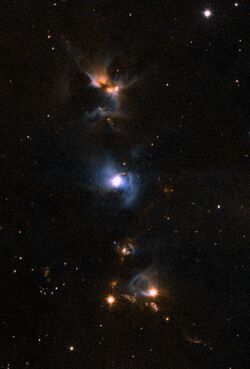Astronomy:HH 24-26
Coordinates: ![]() 05h 46m 7.34s, −00° 13′ 31.3″
05h 46m 7.34s, −00° 13′ 31.3″
| Molecular cloud | |
|---|---|
| Herbig-Haro object | |
 HH 24 (top), HH 25 (below the blue nebula in the middle) and HH 26 (red clouds at the bottom) | |
| Observation data: J2000.0[1] epoch | |
| Right ascension | 05h 46m 07.34s[1] |
| Declination | −00° 13′ 31.3″[1] |
| Distance | 1300 ly |
| Constellation | Orion |
| Designations | HH 24, HH 25, HH 26, JCMTSF J054607.3-001333, HH 24/26, HH 24-26, HH 24-27 |
HH 24-26 is a molecular cloud and star-forming region containing the Herbig-Haro objects HH 24, HH 25 and HH 26. This region contains the highest concentration of astrophysical jets known anywhere in the sky.[2] The molecular cloud is located about 1400 light-years away in the L1630 dark cloud, which is part of the Orion B molecular cloud in the constellation of Orion.[3][4]
The region contains multiple protostars (two class 0 and one class I) and four more evolved IRAS sources. The three protostars are driving the Herbig-Haro objects in this region.[3]
Observation
The L1630 dark cloud also contains NGC 2071 and the Flame Nebula. HH 24-26 is located just a few arcminutes south of Messier 78.[5]
HH 24

The image of HH 24 taken by the Hubble Space Telescope is probably the most well known image of this Herbig-Haro object. HH 24 resembles a lightsaber from the science fiction movies Star Wars and the Hubble image was published during the release of Star Wars Episode VII: The Force Awakens.[6]
HH 24 contains a class 0 protostar, which might be a proto-binary system. The disks around these objects are highly misaligned, which is a sign of turbulent fragmentation.[7]
References
- ↑ 1.0 1.1 1.2 "HH 24-26". SIMBAD. Centre de données astronomiques de Strasbourg. http://simbad.u-strasbg.fr/simbad/sim-basic?Ident=HH+24-26.
- ↑ "Searching for Orphan Stars Amid Starbirth Fireworks" (in en). 2015-09-25. https://www.gemini.edu/node/12429.
- ↑ 3.0 3.1 Benedettini, M.; Giannini, T.; Nisini, B.; Tommasi, E.; Lorenzetti, D.; Di Giorgio, A. M.; Saraceno, P.; Smith, H. A. et al. (July 2000). "The ISO spectroscopic view of the HH 24-26 region" (in en). Astronomy and Astrophysics 359: 148–158. ISSN 0004-6361. Bibcode: 2000A&A...359..148B.
- ↑ Gibb, A. G.; Little, L. T. (February 1995). "HH24 26: structure, dynamics and chemistry" (in en). Astrophysics and Space Science 224 (1–2): 467–468. doi:10.1007/BF00667908. ISSN 0004-640X. Bibcode: 1995Ap&SS.224..467G.
- ↑ Gibb, A. G.; Heaton, B. D. (September 1993). "The star-forming region around HH 24-26 : a revised morphology" (in en). Astronomy and Astrophysics 276: 511–521. ISSN 0004-6361. Bibcode: 1993A&A...276..511G.
- ↑ "The awakened force of a star". 17 December 2015. https://spacetelescope.org/news/heic1526/.
- ↑ Kang, Miju; Choi, Minho; Ho, Paul T. P.; Lee, Youngung (August 2008). "Millimeter Imaging of HH 24 MMS: A Misaligned Protobinary System" (in en). Astrophysical Journal 683 (1): 267–271. doi:10.1086/589819. ISSN 0004-637X. Bibcode: 2008ApJ...683..267K.
External links
Astronomy Picture of the Day
- APOD: 2014 February 4 - A Particle Beam Jet forms HH 24
- APOD: 2015 December 18 - Herbig-Haro 24
- APOD: 2018 March 11 - Dual Particle Beams in Herbig-Haro 24
 |

